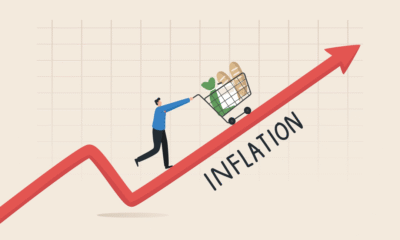Finance
Understanding WealthTech and Robo-Advisors in the U.S.

Introduction to WealthTech
WealthTech refers to the intersection of technology and wealth management, representing a rapidly evolving segment within the financial services industry. This innovative sector encompasses a wide range of tools and platforms designed to enhance the management of personal and institutional assets, leveraging technology to deliver efficient, cost-effective, and personalized financial strategies. With the rise of digital transformation in finance, WealthTech has gained significant traction, fundamentally altering how wealth is managed and advisory services are delivered.
One of the core elements of WealthTech is the integration of advanced technologies such as artificial intelligence, big data analytics, and machine learning into financial advisory processes. These technological advancements enable wealth management firms to analyze vast amounts of data to make informed investment decisions, personalize client interactions, and provide insights that were previously unattainable. As a result, both individuals and institutions can benefit from tailored financial advice that aligns closely with their unique goals and risk tolerance.
The significance of WealthTech extends beyond mere efficiency; it challenges traditional wealth management models that have often been characterized by high fees and accessibility barriers. Through the emergence of various digital solutions, including robo-advisors, WealthTech democratizes access to financial advisory services, allowing a broader audience to engage with their wealth management needs. Consequently, the industry has witnessed a surge in technological platforms that cater to diverse demographics, from young investors seeking low-cost entry points to affluent clients demanding sophisticated investment strategies.
In conclusion, WealthTech represents a transformative force in the financial services landscape, facilitating a shift toward more inclusive, transparent, and efficient wealth management practices. As technology continues to advance, its role in shaping the future of financial advisory services is expected to grow, paving the way for increasingly innovative solutions that cater to the evolving needs of investors.
The Rise of Robo-Advisors
Robo-advisors have emerged as a transformative force in the financial services industry, offering automated, algorithm-driven guidance for investment management. This innovation has significantly shifted the landscape of wealth management in the United States, making financial advice more accessible and affordable to a wider audience. Robo-advisors typically operate under a set of algorithms that assess clients’ financial situations and goals, subsequently creating and managing a diversified investment portfolio tailored to those circumstances.
One of the distinguishing features of robo-advisors is their low cost structure compared to traditional financial advisors. With automated systems handling most of the investment strategies, robo-advisors often charge lower fees and require minimal or no account balances to start investing. This has attracted a demographic of younger, tech-savvy investors who might previously have thought that personalized financial advice was out of reach. Simplicity is another key benefit; the user-friendly interfaces and straightforward account setup processes appeal to new investors navigating the world of securities for the first time.
The proliferation of digital banking and investment platforms has also catalyzed the rise of robo-advisors. Financial technology advancements have provided the infrastructure necessary for these platforms to thrive, offering seamless integration and real-time data analytics to investors. The COVID-19 pandemic further accelerated this trend as individuals sought novel ways to manage their finances from the comfort of their homes. Leading players in this sector, such as Betterment, Wealthfront, and SoFi, have become household names, showcasing a successful model that combines technology and personal finance.
In conclusion, the landscape of personal finance is evolving, propelled by the rise of robo-advisors. These platforms not only democratize investment opportunities but also challenge traditional practices, paving the way for a new era in wealth management.
How Robo-Advisors Work
Robo-advisors utilize sophisticated algorithms and advanced technology to manage investments on behalf of clients, offering a streamlined and efficient alternative to traditional financial advisory services. At the core of a robo-advisor’s operation is an algorithm that assesses each client’s financial situation, investment goals, and risk tolerance. This assessment is typically initiated through an online questionnaire, allowing the robo-advisor to gather necessary information efficiently. Based on the response, the algorithm assigns an appropriate risk profile to the client, which plays a pivotal role in shaping their investment strategy.
Once the risk assessment is completed, the robo-advisor implements a portfolio management strategy that often involves low-cost exchange-traded funds (ETFs) or index funds. These investment vehicles are selected for their potential to provide diversified exposure to various asset classes while minimizing fees. The technology enables continuous monitoring and rebalancing of the portfolio, ensuring that it remains aligned with the client’s risk tolerance and investment objectives. This rebalancing process is crucial, as it helps to maintain the desired asset allocation by periodically adjusting the portfolio as market conditions change.
Robo-advisors also harness advanced data analytics to refine their strategies over time. By leveraging machine learning, these platforms can analyze vast amounts of market data and client behavior, optimizing algorithms for better performance. Furthermore, the automated nature of robo-advisors is complemented by a layer of human oversight. Many firms incorporate financial experts who supervise the algorithms, providing an additional level of credibility and security. Thus, the blend of technology and human insight ensures that robo-advisors not only streamline the investment process but also maintain a focus on achieving clients’ long-term financial goals.
Benefits of WealthTech Solutions
WealthTech solutions, encompassing a range of digital tools and platforms, present numerous advantages for investors. One of the most significant benefits is cost-effectiveness. Traditional wealth management services often entail high fees, which can deter individuals with limited investment capital. In contrast, robo-advisors and other WealthTech platforms offer lower fees, making investment opportunities accessible to a broader audience. This reduction in costs allows more individuals to engage in wealth-building activities, providing an inclusive alternative to conventional financial advising.
Another critical advantage of WealthTech solutions is their accessibility. With the rise of digital technologies, investors can now access investment platforms from anywhere at any time, provided they have internet connectivity. This convenience allows users to manage their portfolios on the go, making it easier to monitor investments and respond to market changes promptly. WealthTech platforms often operate via user-friendly mobile applications and websites, ensuring an intuitive interface for even novice investors.
Furthermore, personalized investment strategies are a hallmark of many robo-advisor platforms within the WealthTech space. These solutions utilize algorithms and artificial intelligence to tailor investment recommendations based on individual risk profiles, financial goals, and time horizons. This level of customization was traditionally reserved for high-net-worth individuals, but WealthTech democratizes access to personalized wealth management strategies for a diverse demographic.
Lastly, enhanced user experiences are a notable feature of WealthTech solutions. The integration of advanced technology allows for intuitive navigation, real-time analytics, and comprehensive educational resources to assist investors in making informed decisions. These platforms typically offer streamlined onboarding processes, removing the barriers that individuals may face when seeking investment opportunities. Overall, WealthTech solutions empower investors by providing cost-effective, accessible, personalized, and user-friendly investment management options.
Challenges and Limitations of Robo-Advisors
Robo-advisors have revolutionized the way individuals manage their investment portfolios, offering automated financial advice and management services. However, despite their growing popularity, there are several challenges and limitations associated with their use that potential investors should carefully consider.
One significant drawback is the limited human interaction inherent in robo-advisory services. Traditional financial advisors provide personalized advice that often involves understanding the client’s unique financial situation, goals, and emotional responses to market fluctuations. In contrast, robo-advisors rely heavily on algorithms and predefined models, which can lead to a generic investing experience. This lack of personal connection may not cater to the nuances of individual investor needs, which can be particularly crucial during market volatility when personalized guidance might be most beneficial.
Moreover, algorithm biases represent another critical concern when engaging with robo-advisors. The models that drive these automated systems are based on historical data and assumptions that may not always account for future market conditions or economic changes. Consequently, investors may inadvertently expose themselves to risks that the algorithms fail to identify, resulting in suboptimal investment strategies. Additionally, the reliance on technology increases the potential for systematic errors, impacting the accuracy of the advice provided.
Lastly, the dependence on technology can be both a boon and a bane. While it offers accessibility and efficiency, it can leave investors vulnerable to technological failures or cybersecurity threats. Issues such as system outages or data breaches may undermine the confidence investors have in these platforms. Overall, while robo-advisors serve as a valuable resource for many, it is essential to acknowledge and weigh these challenges when deciding to employ their services, ensuring that individual financial goals and circumstances are adequately considered.
The Competitive Landscape in the U.S. WealthTech Market
The WealthTech market in the United States is characterized by a dynamic and competitive environment, populated by a diverse array of players including established financial institutions, innovative startups, and tech-driven financial service providers. As of 2023, major firms like Vanguard and Charles Schwab continue to leverage technology to enhance their service offerings, embracing WealthTech solutions to improve customer engagement and operational efficiency. These traditional firms are increasingly incorporating robo-advisors into their portfolios, recognizing the growing consumer preference for automated investment solutions.
Emerging startups such as Wealthfront and Betterment also play a significant role in reshaping the WealthTech landscape. These companies have successfully attracted a younger demographic by offering user-friendly platforms characterized by low fees and simplicity. Their focus on personalized investment strategies through advanced algorithms has set a new standard in customer acquisition and retention. The competitive strategy adopted by these firms emphasizes flexibility and transparency, appealing to a market that values trust and accessibility in financial management.
In addition to established companies and startups, the integration of artificial intelligence and machine learning into investment strategies has become a prevailing trend amongst WealthTech firms. This technological advancement enables companies to analyze vast amounts of data rapidly, facilitating better decision-making processes and enhancing client experiences. Moreover, the rise of ESG (Environmental, Social, and Governance) criteria in investment strategies reflects the changing values of investors, further influencing the competitive dynamics of the WealthTech market. Companies that align their offerings with these trends are likely to gain a competitive edge.
As a result, the U.S. WealthTech marketplace is continually evolving, propelled by innovation and shifting consumer expectations. Both legacy financial institutions and new entrants must stay informed about these trends to remain relevant in this competitive arena.
Regulatory Environment for WealthTech and Robo-Advisors
The regulatory environment governing WealthTech and robo-advisors in the United States is complex and continually evolving. As technology advances and democratizes access to financial services, regulators are grappling with how to adequately protect consumers while fostering innovation within the industry. Key regulations impacting these platforms include the Investment Advisers Act of 1940, which mandates that advisors, including robo-advisors, register with the Securities and Exchange Commission (SEC) or state authorities, depending on their assets under management. This act serves to ensure transparency and fiduciary responsibility, compelling advisors to act in the best interests of their clients.
In addition to federal regulations, many states have their own mandates that can affect WealthTech solutions and robo-advisors. For instance, some states have implemented stricter guidelines concerning customer data protection and cybersecurity measures, directly impacting how these firms operate. Compliance with such regulations presents significant challenges, especially for startups that may lack the resources to navigate the intricate legal landscape. This compliance burden can slow down the adoption of innovative technologies that could potentially enhance service delivery and customer experience.
Furthermore, the Financial Industry Regulatory Authority (FINRA) has issued guidance regarding the application of existing regulations to online advisory services. As robo-advisors often integrate algorithms to manage portfolios automatically, the alignment of these services with existing investment advisory regulations is critical. This evolving regulatory framework not only influences how WealthTech companies design their offerings but also shapes consumer perception and trust in these services. By understanding these regulations and their implications, both providers and consumers can better navigate the WealthTech landscape, ensuring that innovations in financial technology are both effective and secure.
Future Trends in WealthTech and Robo-Advisory Services
The WealthTech sector is rapidly evolving, driven by continuous advancements in technology and changing consumer preferences. As we look toward the future, several key trends are poised to shape the landscape of robo-advisors and WealthTech solutions. One of the most significant developments is the integration of artificial intelligence (AI) and machine learning into investment management platforms. These technologies enhance the capabilities of robo-advisors by enabling more personalized and sophisticated investment strategies. By analyzing vast amounts of data, AI algorithms can identify emerging market trends, assess risk more accurately, and optimize portfolio allocations in real time.
Another trend gaining prominence is the rising importance of Environmental, Social, and Governance (ESG) factors in investment decisions. As investors become increasingly aware of the impact their choices have on the world, there is a growing demand for robo-advisors that offer ESG investing options. WealthTech firms are responding to this demand by developing platforms that allow users to align their investments with their values. By providing transparent information about the social and environmental impact of investments, these platforms not only attract conscious investors but also foster a more sustainable and responsible financial landscape.
Moreover, the ongoing shift toward mobile and digital solutions is likely to expand the accessibility of robo-advisory services. As more consumers embrace technology for their financial needs, it is anticipated that WealthTech companies will innovate their user interfaces to provide seamless, user-friendly experiences. This growing focus on mobile accessibility and usability will be crucial in attracting younger demographics, who are more inclined to seek out financial services that fit their digital lifestyles. Overall, the future of WealthTech and robo-advisory services appears promising, characterized by enhanced personalization, responsible investing, and increased accessibility, setting the stage for greater investor empowerment.
Conclusion: The Future of Wealth Management
The landscape of wealth management is undergoing a significant transformation, driven primarily by the advancements in WealthTech and the increasing adoption of robo-advisors. Throughout this blog post, we have explored the intricacies of these innovations, highlighting their role in reshaping investment strategies and financial advisory services. WealthTech encompasses a wide range of technological solutions designed to enhance the delivery of financial services, making them more efficient and accessible to a broader audience. The emergence of robo-advisors, in particular, has democratized investment management, allowing individuals with varying levels of financial literacy and capital to engage in the financial markets.
Robo-advisors utilize algorithms to provide personalized investment advice at a fraction of the cost traditionally associated with human advisors. This accessibility not only empowers more individuals to participate in wealth creation but also encourages a greater understanding of financial principles among the general population. The ability of these digital platforms to analyze user data and adapt to changing market conditions positions them as a vital component of modern investment strategies. Furthermore, the incorporation of AI and machine learning continues to refine these services, enhancing their accuracy and efficiency.
<pas a="" about="" adapt="" advancements="" advice.="" advisors="" alike="" also="" and="" anticipated="" base="" benefits="" but="" can="" capabilities="" changes="" contribute="" crucial="" decision-making="" developments.="" empowered="" engaging="" enhance="" ensure="" even="" evolves,="" expand="" experiences="" financial="" for="" forward.
Investing
Global Investor Outflows from U.S. Stocks & Dollar

In a shift that is sending ripples across financial markets, institutional investors around the world are pulling back from U.S. equities and reducing exposure to the U.S. dollar, signaling a significant change in sentiment toward American assets. According to the latest Bank of America Global Fund Manager Survey, global investors are now the most underweight on U.S. stocks in more than two decades, with the dollar facing similar skepticism as a long-term safe-haven asset. This transition is being fueled by multiple converging factors, including geopolitical instability, growing U.S. fiscal deficits, trade tensions, and an increasingly favorable investment climate in Europe and select emerging markets. For investors, economists, and policymakers alike, this trend represents a rebalancing of global capital flows that could reshape market dynamics in the months ahead.
Investor Sentiment Toward U.S. Markets Hits Multi-Year Lows
The Bank of America survey, considered a key barometer of global institutional sentiment, reveals that fund managers have turned heavily underweight on U.S. stocks and the dollar, preferring instead to rotate their portfolios into European and Asian equities. The survey showed that 36% of participants are now net underweight U.S. equities—the highest level since 2003. At the same time, positioning on the dollar turned net negative for the first time in over five years, with investors citing mounting fiscal concerns, valuation extremes, and weakening macroeconomic indicators.
The U.S. equity market, especially the tech-heavy NASDAQ, has experienced an extraordinary bull run over the last several years. But now, investors are questioning the sustainability of elevated valuations, particularly as economic growth slows, earnings forecasts are revised downward, and inflation remains persistently above target. Many portfolio managers believe the best returns may no longer be found in U.S. assets alone.
Rising U.S. Debt and Fiscal Deficits Raise Red Flags
A key driver of investor caution is the ballooning U.S. fiscal deficit. The Congressional Budget Office (CBO) projects that the U.S. federal deficit will reach over $1.8 trillion this year, driven by increased government spending, rising interest costs, and lower-than-expected tax revenues. The national debt is now projected to exceed 125% of GDP by 2030, raising serious questions about long-term fiscal sustainability.
Investors fear that soaring U.S. debt levels could lead to a loss of confidence in Treasury securities, pushing yields higher and triggering volatility in global credit markets. This concern is magnified by the growing political polarization in Washington, which has led to repeated debt ceiling standoffs and policy gridlock. As a result, some asset managers are choosing to diversify their bond portfolios with sovereign debt from countries like Germany, Canada, and Australia—nations viewed as having stronger fiscal discipline.
Geopolitical Tensions Erode Dollar Safe-Haven Appeal
The traditional role of the U.S. dollar as a global safe-haven currency is also being called into question. With the U.S. now embroiled in rising geopolitical conflicts, including its military engagement in the Middle East and an escalating trade war with China, the perception of the dollar as a “neutral” or stable currency is beginning to fade. Several countries, particularly in the Global South, have voiced frustration over the dominance of the dollar in international trade, and some have even accelerated efforts to settle trade in alternative currencies such as the euro, yuan, or local currency blocs.
In response, central banks in emerging markets are reducing their U.S. dollar reserves and increasing holdings in gold and non-dollar currencies. This trend, while gradual, is gaining momentum and contributing to the dollar’s underperformance against a basket of global currencies. The U.S. dollar index (DXY) has declined by nearly 6% year-to-date, reflecting both diminished investor confidence and a broader reconfiguration of reserve management strategies.
Attractive Valuations Abroad Drive Capital Outflows
While risks in the U.S. are mounting, attractive investment opportunities abroad are also contributing to the outflow of capital from American markets. European equities, particularly in sectors like green energy, luxury goods, and financial services, are seeing renewed interest thanks to relatively low valuations and improving macroeconomic stability. The recent ECB rate cuts and Eurobond discussions have added to optimism about the region’s fiscal and financial integration.
In Asia, countries like India, Indonesia, and Vietnam are emerging as new hotspots for foreign direct investment and equity inflows. These economies offer robust growth prospects, younger demographics, and increasingly tech-driven industries. Additionally, Japan’s bond market is seeing increased institutional buying, as long-term yields rise in response to the Bank of Japan’s policy changes.
This global diversification strategy is not just about seeking higher returns—it’s also about managing risk. Investors are increasingly looking to balance their portfolios geographically, reducing dependence on any single region and hedging against macroeconomic shocks that may be specific to the U.S.
Currency Hedging and Diversification as Defensive Strategies
In response to the dollar’s volatility, many fund managers are now engaging in currency hedging strategies to protect their portfolios. Currency ETFs, options, and forward contracts are being used to minimize the downside risk of a weakening dollar. At the same time, global investment funds are ramping up their exposure to non-dollar-denominated assets, including eurozone corporate bonds, emerging market debt, and local-currency sovereign issues.
Moreover, ESG and green bond markets in Europe and Asia are attracting capital due to their alignment with global sustainability goals. These instruments not only offer diversification but also align with broader institutional mandates on responsible investing.
Implications for U.S. Markets and Monetary Policy
The capital flight from U.S. assets could have significant implications for American markets. A persistent decline in foreign demand for U.S. Treasuries may force the Federal Reserve to intervene more frequently in the bond market to maintain liquidity and control yields. At the same time, a weaker dollar could contribute to imported inflation, complicating the Fed’s efforts to bring core inflation back within its target range.
On the equities side, if investor outflows persist, U.S. companies may face higher capital costs and declining valuations, particularly in sectors that rely heavily on foreign investment or exports. Domestic pension funds and institutional investors may need to fill the gap left by global investors, which could further alter asset allocation strategies and influence corporate financing decisions.
A New Era of Global Capital Rotation
The growing shift away from U.S. stocks and the dollar signals the beginning of a new era in global investing, one defined by diversification, geopolitical hedging, and currency rebalancing. While the U.S. remains a central player in global finance, the days of unquestioned dominance are beginning to fade, as investors embrace a more nuanced and distributed view of risk and opportunity.
For market participants, staying agile in this environment means tracking global fund flows, monitoring geopolitical developments, and reassessing the traditional U.S.-centric portfolio model. As capital continues to flow into European and Asian markets, the future of global finance is being rewritten—and those who adapt early may find themselves ahead of the curve.
Finance and Economy
France Pushes Eurozone Toward Joint Eurobond Issuance

In a bold move that could redefine the financial architecture of the European Union, France has renewed its push for the issuance of joint eurozone debt instruments – commonly referred to as Eurobonds – as a way to strengthen the euro on the global stage. As the EU prepares for its upcoming summit on June 26-27, the proposal is once again stirring heated debate among member nations. French officials argue that a shared debt mechanism is essential not only for financial resilience but also for elevating the euro’s standing as a credible alternative to the U.S. dollar. While the idea garners support from key institutions like the IMF and the ECB, resistance from fiscally conservative member states continues to block consensus. This article explores the implications of France’s proposal, the potential benefits and challenges of Eurobond issuance, and the evolving role of the euro in a multipolar financial world.
France’s Strategic Case for Eurobonds
French President Emmanuel Macron and Finance Minister Bruno Le Maire have long been advocates for deeper EU financial integration. According to them, Eurobonds would represent a tangible step toward fiscal solidarity and monetary cohesion, allowing member nations to borrow at collectively favorable rates while demonstrating political unity. The latest push comes at a time when the European economy is facing several headwinds: slowing growth, fragmented recovery across member states, and heightened global financial volatility triggered by geopolitical conflicts and energy insecurity. Macron has reiterated that a common debt tool is essential for financing major EU-wide projects such as green energy transition, digital infrastructure, and military defense.
From a strategic standpoint, France views Eurobonds as more than just a financial mechanism – they are a symbol of EU credibility and resilience. By pooling risk and aligning borrowing capacity, the eurozone could present a united front in capital markets, reducing the vulnerability of weaker economies and improving the euro’s attractiveness to foreign investors.
The Euro’s Current Global Standing and Its Challenges
Despite being the world’s second most-used currency, the euro still lags far behind the U.S. dollar in terms of global reserve share, trade settlement, and safe-haven preference. Analysts point out that one of the primary reasons for this is the fragmented nature of the eurozone bond market. Each country issues its own sovereign debt, leading to a lack of a single, risk-free eurozone bond benchmark – unlike U.S. Treasuries, which offer deep liquidity and low risk.
France’s proposal seeks to address this imbalance. A unified Eurobond market could create a highly liquid, stable, and scalable financial product that would attract central banks, pension funds, and sovereign wealth investors. Over time, this could shift more global reserves into euros, boosting the currency’s influence in global trade and finance.
Institutional Support: IMF, ECB, and Market Participants
Key international organizations have thrown their weight behind the idea. The International Monetary Fund (IMF) has suggested that Eurobonds could enhance the EU’s fiscal capacity and crisis response agility. Meanwhile, European Central Bank (ECB) officials, including President Christine Lagarde, have hinted that deeper fiscal integration is necessary for the euro to realize its full potential.
Financial market participants have also shown interest. Asset managers argue that Eurobonds could become a cornerstone of fixed-income portfolios, particularly for investors looking to diversify away from dollar-denominated assets. Some analysts compare the opportunity to the creation of the U.S. Treasury market in the post-war era, which laid the groundwork for the dollar’s global dominance.
Opposition from the Frugal Four and Risk-Sharing Concerns
Despite France’s enthusiasm and institutional support, significant opposition persists from fiscally conservative EU nations, notably Germany, Austria, the Netherlands, and Finland—often dubbed the “Frugal Four.” These countries argue that shared debt would penalize responsible fiscal behavior and open the door to moral hazard, where weaker economies might overborrow under the protection of joint guarantees.
German officials have also cited constitutional constraints and public opposition to any perceived “debt mutualization.” Instead, they advocate for reforms at the national level, more stringent budget controls, and the use of existing mechanisms like the European Stability Mechanism (ESM) for crisis funding.
This divide continues to stall formal negotiations. At the heart of the debate is the question of trust and fiscal governance, as many northern states remain skeptical about the long-term commitment of their southern counterparts to austerity and budget discipline.
Implications for Financial Markets and Investors
If approved, Eurobonds would be a game-changer for European capital markets. They would offer a new safe asset class, potentially rivaling U.S. Treasuries in size and reliability over the long term. For the European banking system, Eurobonds could provide high-quality collateral and improve liquidity conditions, especially for cross-border lending.
Investors are closely monitoring the situation. If the EU takes concrete steps toward joint bond issuance, bond yields across peripheral economies like Italy, Spain, and Greece could compress further, as risk premia shrink in anticipation of shared guarantees. Simultaneously, euro-denominated assets may see a surge in foreign inflows, especially from central banks seeking to rebalance reserve portfolios.
Strengthening the Euro’s Role in a Multipolar World
The geopolitical landscape is increasingly defined by multipolarity, with China, Russia, and the U.S. competing for influence in trade, finance, and security. In this context, the eurozone faces a historic opportunity to carve out a more assertive role. Strengthening the euro through fiscal and capital market integration is seen as essential to counterbalance the dollar’s dominance and reduce reliance on U.S.-led financial infrastructure.
Eurobonds could serve as a financial pillar in this transition. As global investors seek alternatives in a fragmented world economy, the euro’s rise as a stable, investable, and liquid currency backed by joint instruments could bolster its credibility and utility.
A Defining Moment for European Unity
France’s push for Eurobonds is more than just a fiscal proposal – it is a call for political and financial unity in a time of global uncertainty. While the road to consensus is steep, the growing support from institutions, investors, and southern EU members suggests that momentum is building. The upcoming EU summit will be a crucial test of the bloc’s ability to move beyond national interests and toward a shared financial future.
If successful, Eurobond issuance could redefine the eurozone’s role in the global economy, offering new tools for crisis response, economic development, and financial competitiveness. For investors and policymakers alike, this moment marks a critical juncture – either Europe seizes the opportunity to lead, or it risks remaining a secondary player in a rapidly evolving financial world.
Finance and Economy
Oil Price Spike as Middle East Conflict Deepens: A Global Market Wake-Up Call

The financial world is once again on high alert as escalating tensions in the Middle East have triggered a sharp surge in global oil prices, sending shockwaves through equity, commodity, and currency markets alike. With the U.S. reportedly striking Iran’s nuclear sites, Brent crude surged over 18%, nearing $80 per barrel in a matter of hours. The sudden volatility reignited fears of a potential $100 oil scenario, reminiscent of past geopolitical flashpoints that deeply impacted global supply chains, inflation expectations, and central bank policy stances. This article delves into the causes, consequences, and global financial implications of this emerging crisis.
The Trigger: U.S. Strikes on Iran’s Nuclear Infrastructure
On June 21, 2025, international news outlets confirmed that U.S. military forces had targeted Iranian nuclear facilities in what they described as a “pre-emptive defensive measure.” While the full extent of the damage is still being assessed, the attack has clearly escalated tensions in an already volatile region. The Middle East, being a vital hub for global oil production and shipping, plays a significant role in maintaining supply stability. Iran, which controls access to the Strait of Hormuz – a key chokepoint through which nearly 20% of the world’s oil supply passes—responded with threats to close the strait and intensify its military posturing. This heightened the risk premium in energy markets virtually overnight.
Oil Prices React Swiftly to Geopolitical Instability
Crude oil, especially Brent and West Texas Intermediate (WTI), reacted with extreme sensitivity to the developments. Brent crude jumped over 18% within a 24-hour period, while WTI saw a comparable surge. Analysts at Goldman Sachs and JPMorgan warned that if the Strait of Hormuz were to be blocked, prices could surpass $100 per barrel within weeks. The last time the oil market saw such an intense geopolitical premium was during the 2019 drone attacks on Saudi oil facilities. However, the current situation has a more severe undertone due to the involvement of nuclear assets and direct military strikes between two powerful adversaries.
Safe Haven Assets Soar as Risk Appetite Declines
As is common in times of geopolitical crisis, investors flocked to safe-haven assets such as gold, the U.S. dollar, and U.S. Treasuries. Gold climbed above $2,400 per ounce, a level not seen in years, while the U.S. dollar index rose nearly 2% as capital fled emerging markets and riskier assets. Meanwhile, 10-year U.S. Treasury yields fell sharply, reflecting a surge in demand for perceived low-risk instruments. Cryptocurrency markets, particularly Bitcoin, experienced a brief rally as some investors viewed digital assets as alternative stores of value, although that rally quickly reversed amid broader market instability.
Stock Markets Face Broad Sell-Off, Led by Energy-Sensitive Sectors
Equity markets around the globe responded negatively. The S&P 500 and NASDAQ both dropped over 2.5% in intraday trading, led by declines in consumer discretionary, industrials, and airline stocks, which are highly sensitive to fuel price increases. European indices such as the FTSE 100 and DAX also saw steep losses, while Asia-Pacific markets like the Nikkei 225 and Hang Seng Index fell sharply as investors priced in a higher global risk premium. Interestingly, energy stocks provided the only bright spot in an otherwise red sea of market activity, with companies like ExxonMobil and Chevron posting strong gains on expectations of rising revenues.
Inflationary Pressures Could Derail Central Bank Strategies
The surge in oil prices couldn’t have come at a worse time for global central banks. After years of battling inflation through aggressive interest rate hikes, many central banks had only just begun to pause or consider rate cuts in 2025. However, higher energy prices feed directly into inflation, particularly in transport, manufacturing, and agriculture sectors, potentially forcing monetary authorities to reverse their dovish pivot. The European Central Bank (ECB), which had recently initiated its first rate cut in years, may now face pressure to hold off on further easing. Similarly, the Federal Reserve, which had opted to maintain its current rate in the last FOMC meeting, is likely to adopt a more hawkish tone moving forward.
Emerging Markets Bear the Brunt of the Crisis
The fallout from spiking oil prices is especially damaging for emerging markets, which are typically more sensitive to commodity price fluctuations. Countries like India, Turkey, and South Africa, which are major oil importers and have significant current account deficits, saw their currencies depreciate against the dollar. This adds to inflationary pressures and increases the cost of dollar-denominated debt, complicating fiscal and monetary policy responses. Foreign institutional investors also withdrew capital from these markets, adding to equity market stress and further depressing sentiment.
Global Economic Growth at Risk
Economists are revising down global GDP forecasts amid fears that higher oil prices will dampen consumer spending, elevate production costs, and destabilize corporate earnings. According to the IMF, a sustained oil price above $90 could reduce global GDP growth by 0.5% annually, with some regions like Southeast Asia and Sub-Saharan Africa experiencing even greater negative impacts. Supply chains, already recovering from post-pandemic disruptions and trade tensions, now face renewed uncertainty due to potential shipping bottlenecks in the Persian Gulf.
Outlook: What Comes Next for Markets and Policymakers?
Going forward, much depends on how the situation in the Middle East evolves. A de-escalation through diplomatic channels, possibly via UN or EU mediation, could stabilize oil prices and soothe market nerves. On the other hand, if Iran follows through on its threat to block the Strait of Hormuz or retaliates militarily, the crisis could escalate into a full-blown regional conflict with severe repercussions for global trade and energy supply. Policymakers worldwide are monitoring the situation closely, and emergency meetings by OPEC and G20 finance ministers are already being planned. The International Energy Agency (IEA) has also signaled its willingness to release strategic petroleum reserves if needed to calm markets.
The Road Ahead is Uncertain but Manageable
In the face of rising geopolitical tensions and economic uncertainty, investors are advised to adopt a cautious, diversified approach. While markets remain volatile and unpredictable, sound investment principles – such as maintaining a balanced portfolio, avoiding over-leveraged positions, and focusing on long-term fundamentals – remain more relevant than ever. The oil price spike triggered by the U.S.-Iran conflict is a potent reminder of how global politics and finance are deeply intertwined, and why staying informed and agile is critical in today’s interconnected world.
-

 Finance & Investment6 months ago
Finance & Investment6 months agoEmerging Markets to Watch in 2025: Opportunities and Risks
-

 Technology and Finance8 months ago
Technology and Finance8 months agoThe Future of Quantum Computing in Financial Modeling and Trading
-

 Finance7 months ago
Finance7 months agoUSA Market Trends & Global Finance Insights
-
Finance7 months ago
Navigating Retirement in the Gig Economy: Challenges and Solutions
-

 Finance8 months ago
Finance8 months agoNavigating Personal Finance in the Age of Inflation and High Interest Rates
-

 Economics6 months ago
Economics6 months agoGlobal Markets React to U.S. GDP Contraction: A Comprehensive Analysis
-

 Investing & Finance8 months ago
Investing & Finance8 months agoFractional Investing: The Path to Wealth Democratization
-

 Finance7 months ago
Finance7 months agoTop 10 High-Yield Savings Accounts in the US (2025 Edition)




